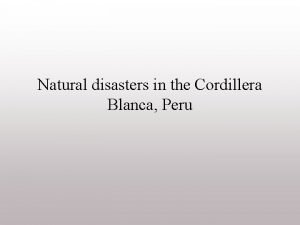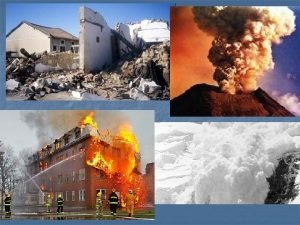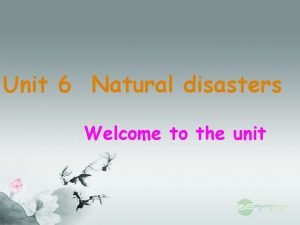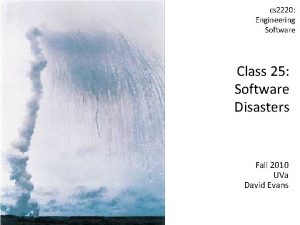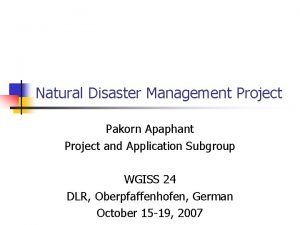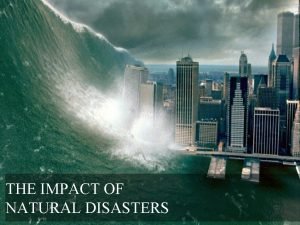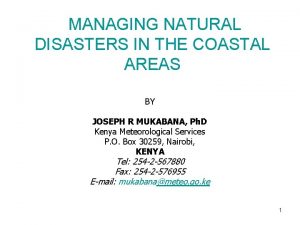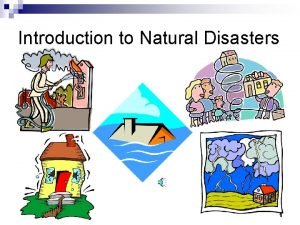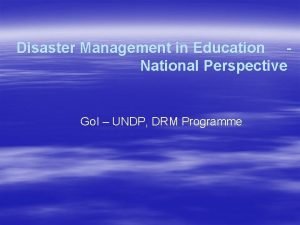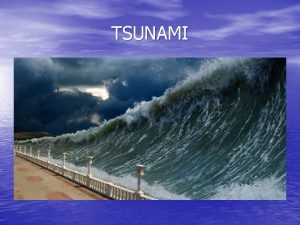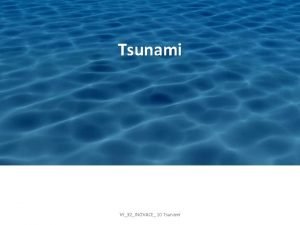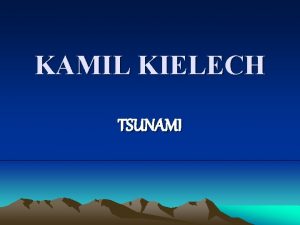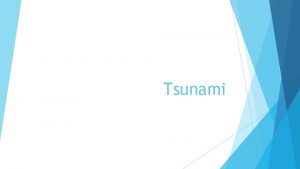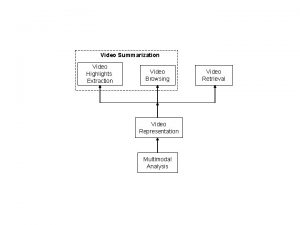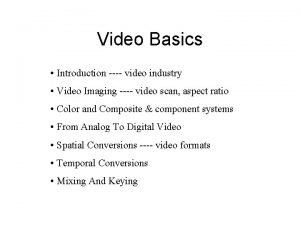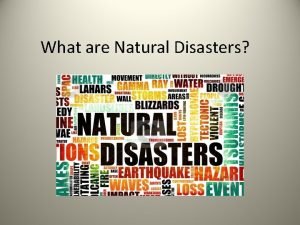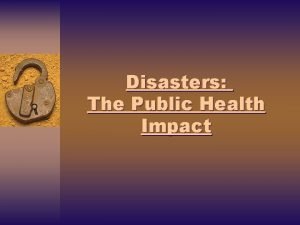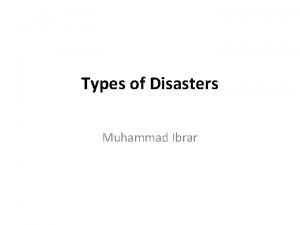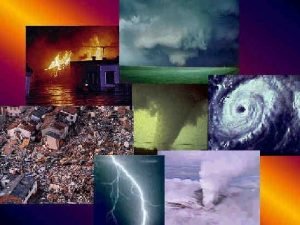VIDEO OF TSUNAMI 1 Disasters of tsunami 2





















- Slides: 21

VIDEO OF TSUNAMI 1

Disasters of tsunami 2

Disasters of tsunami 3

Tsunami Terror : A Brief Chronology • July 21, 365 : Tsunami waves shook the eastern Mediterranean killing • • • thousands of Egyptians in Alexandria. November 1, 1775 : The great Lisbon earthquake generated a wave up to 6 m high striking coastal Portugal, Spain & Morocco. August 27, 1883 : The eruption of Krakatau volcano generated a massive wave killing 36, 000 people near the shores of Java and Sumatra. June 15, 1896 : A wave over 23 m high killed 26, 000 people in Japan. January 31, 1906 : An offshore quake generated a wave killing 500 -1, 500 people in Columbia, Ecuador and Micay. April 01, 1946 : Alaskan quake generated wave killed 159 people in Hawaii. May 22, 1960 : A wave reported 11 m high killed 1, 000 people in Chile. March 28, 1964 : Alaskan quake generated wave killed 107 people in Alaska. August 16, 1976 : A tsunami killed 5, 000 people in the Moro Gulf region of Philippines. July 17, 1998 : An offshore quake triggered wave killed 2, 000 people of Papua-New Guinea. And we all know the losses of the tsunami last year on 26 th December 2004. 4

What Are Tsunamis? • Tsunamis are ocean waves produced by earthquakes or • • • underwater landslides. The word is Japanese and means "harbor wave, " because of the devastating effects these waves have had on low-lying Japanese coastal communities. A tsunami is actually a series of waves that can travel at speeds averaging 450 (and up to 600) miles per hour in the open ocean. As the waves approach the coast, their speed decreases and their amplitude increases. Unusual wave heights have been known to be over 100 feet high. However, waves that are 10 to 20 feet high can be very destructive and cause many deaths or injuries. 5

Why Talk About Tsunamis? · The Tsunami last year on 26 th December devastated lives around the Indian Ocean claiming thousands of lives, millions as injured, numerous as unsheltered and uncountless lost their family and loved ones. · Twenty-four tsunamis have caused damage in the United States and its territories during the last 204 years. · Just since 1946, six tsunamis have killed more than 350 people in the U. S. alone. · Tsunamis can travel upstream with damaging waves extending farther inland than the immediate coast. · A tsunami can occur during any season of the year and at any time, day or night. 6

Causes Of Tsunami • Tsunamis are most often generated by earthquake-induced • movement of the ocean floor. Landslides, volcanic eruptions, and even meteorites can also generate a tsunami. Areas Prone to Tsunami v The Indian coastline from Gujrat to West Bengal. v The continent of Australia. v Other countries like Sri Lanka, Japan, Indonesia, Thailand, v Philippines, Malaysia, Oman, Yemen, etc. in the Indian Ocean, Bay of Bengal & Arabian Sea. Then there are other countries like Cuba, Peru, U. S. Canada, 7 Russia, Madagascar, etc.

How should India respond to the crisis? • Tsunami cannot be prevented, but they can be detected, and • • • warnings can go out if you're prepared. We can have seismic detectors, in the Indian Ocean as the one in the Pacific Ocean so as to determine whether an earthquake occurred and gauges to measure the impulse of water, whether a wave has been created. Once a wave impulse passes those gauges, an alarm is raised on the tsunami net, sirens are sounded on affected shorelines and people need to get to high ground as quickly as possible. The other part is educating the populace. Then, even if we don't have a warning system, they'll know that if the sea starts to retreat, they need to head away from the sea, not toward it. 8

Need of a Warning System • The destructions caused by Tsunamis are now nothing alien to • anyone and besides this all people have a right to live. The time between successive wave crests varies from 5 to 90 minutes and thus a warning in time can save quite a number of lives as some coastal community is facing a destructive tsunami on the other hand other may experience no damaging waves. 9

principle of Warning • The system are based on earthquake data for rapid initial • warning and water level data for confirming and monitoring tsunami or for canceling of warning. They rely on a variety of communications channels to receive seismic and water level data, & to issue messages to appropriate authorities. The centers should BE v Providing warnings as soon as possible after a potential tsunami generation. v accurate – issuing warnings for all destructive tsunamis while minimizing false warnings. 10 v reliable – making sure they operate continuously.

A Real time tsunami reporting system • A sensor that is a water level gauge • • is deployed in the mid ocean and it sends signals to the buoy on the surface. The buoy the relays this signals to the warning centers with the help of a TOPEX/POSIEDON or JASON Satellites. Now, it is the responsibility of the center to assess the situation and issue warnings if required. 11

Water level gauge • Water-level gauges are an essential element of tsunami • • • warning systems. They confirm the existence or non-existence of tsunami waves following an earthquake. They monitor the tsunami's progress, to help estimate the severity of the hazard. Water level gauges may also be the only way to detect a tsunami in case it is not earthquake generated. 12

Types of water level gauges • Stilling Well • Pressure Transducers • Run-up Gauges 13

Stilling Wells • Tide gauges typically use a stilling well to eliminate the higher frequency wind wave signals. • A stilling well is usually a long hollow vertical cylinder, sealed at the bottom except for a small opening, and mounted on the side of a pier so it extends into the ocean. • Seawater inside the cylinder rises and falls with the slowly changing tides, but the small opening at the bottom restricts the flow so that much higher frequency wind-driven waves and swell have little effect on the level. • Waves of frequency in between the 2 extremes can pass into the well but with reduced amplitude and delay. • Measurements of water level can be made with mechanical or acoustical techniques. 14

Drawbacks of stilling wells • Silt and marine growth in the area of the orifice. This will • cause the orifice to become effectively smaller and eventually block it completely. Errors can be caused by the water in the well not being of the same density as that outside the well. OVERCOMING THE DEFECTS The shortcomings of the stilling wells are overcome by the use of a pressure transducer as its sensor. 15

Pressure transducer • • This type of sensor converts the water pressure, which is directly proportional to the water level, into a voltage. It can be mounted on the ocean bottom offshore and be connected to a land station by an electrical signal cable. FEATURES: • • • High accuracy and reliability. Completely submersible. Compact, rugged design for easy installation. Minimal maintenance and care. Water level sensor compatible with most monitoring equipment. 16

Advantages of a Pressure Transducers • It can measure a great range of water levels and accommodate even large tsunamis. • It has a wider frequency response to measure tsunamis signals without distortion. • They can be deployed in places where other sensors cannot be deployed. 17

RUN-UP GAUGES It is under development of U. S. A. These types of gauges are the future sensors to be used simply due to the following reasons: • It can be located entirely on land. • Hence it is simpler to install. • Also it will be easier to maintain it. • Moreover they will be less expensive to build than most of the reliable sensors. 18

Satellite for relaying signals • The satellite used is called as TOPEX/POSEIDON or Jason. • This satellite is made by NASA. • It costs around 20 million dollars. 19

Some warning centers of the world • • • The Pacific Tsunami Warning Center (1948). The West Coast/Alaska Tsunami Warning Center (1968). The Japanese Tsunami Warning Center (1952). The U. S. S. R. Warning Center (1952). The French Polynesia Warning Center (1965). The National Tsunami Warning Center of Chile (1964). However, it is worth noting that even though we (INDIA) are a peninsular we still do not have such a system or center and we have paid a price for this folly. May be now our country will have a Warning System of its own. 20

This seminar on: TSUNAMI WARNING SYSTEMS Was presented by: Shaikh Abdul Kadar Moin III rd year I. E. (025645) 21 M. H. S. S. P.
 Httptw
Httptw The frame size of a video refers to the video’s
The frame size of a video refers to the video’s Yandex video
Yandex video Yahoo gravity
Yahoo gravity Cordillera natural disasters
Cordillera natural disasters Accidents & disasters
Accidents & disasters Natural disasters listening comprehension
Natural disasters listening comprehension Three natural disasters
Three natural disasters Software engineering disasters
Software engineering disasters Natural disasters
Natural disasters What are disasters
What are disasters Natural hazards vs natural disasters
Natural hazards vs natural disasters Principles of disaster management
Principles of disaster management Effects of environmental disasters
Effects of environmental disasters Conclusion of natural disasters
Conclusion of natural disasters Unit 9 natural disasters
Unit 9 natural disasters Conclusion of disaster management
Conclusion of disaster management Introduction of natural disaster
Introduction of natural disaster Helike greece
Helike greece Characteristics of hazards
Characteristics of hazards Man-made disasters introduction
Man-made disasters introduction Aqa english language paper 2 rail disasters model answers
Aqa english language paper 2 rail disasters model answers




